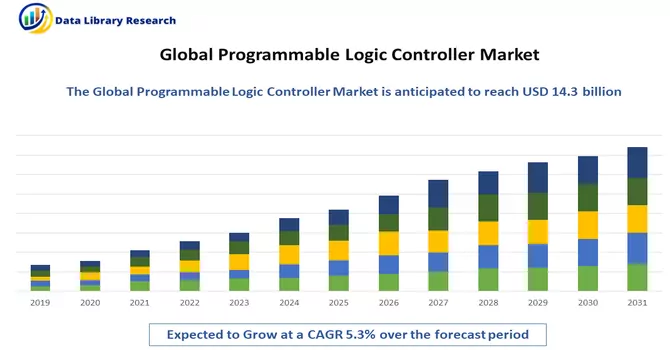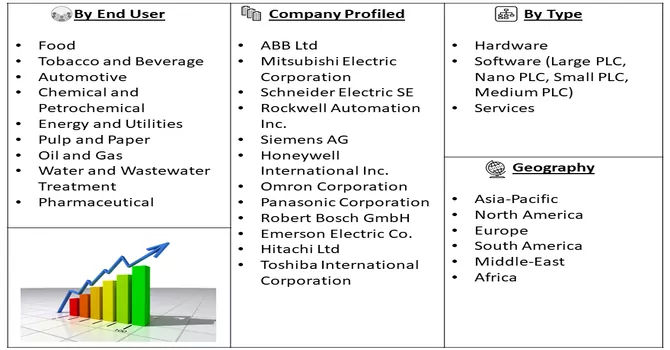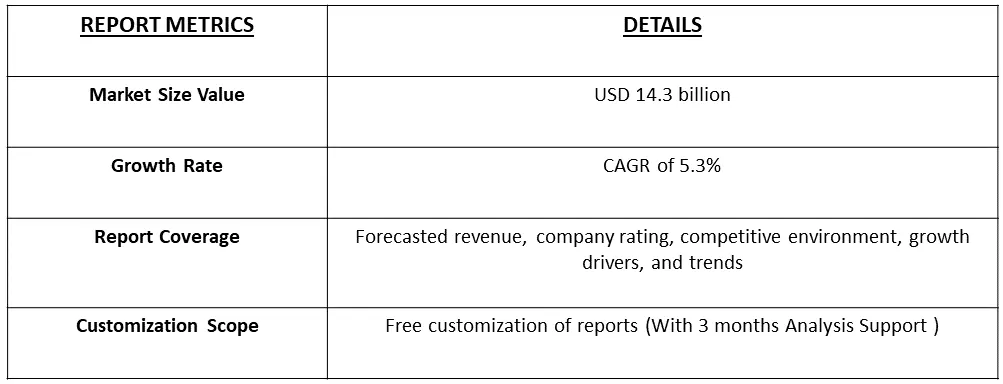The Programmable Logic Controller Market size is estimated at USD 14.3 billion in 2023 and is expected to register a CAGR of 5.3% during the forecast period (2024-2031).

Get Complete Analysis Of The Report - Download Free Sample PDF
A Programmable Logic Controller (PLC) is a specialized industrial computing device designed for the control and automation of manufacturing processes and machinery. PLCs are used in various industries, including manufacturing, automotive, chemical, and others, to automate and control the operation of machinery and processes on the factory floor. PLCs are programmable and can be customized to perform specific tasks based on the inputs received from sensors and other devices. They are equipped with digital and analogue input and output modules, allowing them to interact with sensors, switches, actuators, and other industrial devices. The programming of a PLC involves creating a set of logic instructions that determine how the controller should respond to different inputs, enabling it to control the operation of machines, monitor processes, and make real-time decisions. PLCs play a crucial role in industrial automation, offering reliability, flexibility, and ease of programming. They contribute to improving efficiency, reducing human intervention, and ensuring precise control in industrial processes.
The Programmable Logic Controller (PLC) market experiences robust growth driven by the widespread adoption of industrial automation across various sectors. As industries embrace smart manufacturing and Industry 4.0 practices, PLCs play a pivotal role in providing efficient control, real-time monitoring, and connectivity. The emphasis on operational efficiency, scalability, and compliance with safety standards further fuels the demand for PLCs. Their flexibility allows easy customization, adapting to evolving production needs. Additionally, the integration of PLCs with the Internet of Things (IoT) enhances connectivity and enables predictive maintenance, contributing to the overall expansion of the PLC market as a crucial component of modern industrial ecosystems.
The trends in the Programmable Logic Controller (PLC) market were characterized by a growing emphasis on Industry 4.0 integration, increased demand for modular and scalable PLC solutions, and a shift towards cloud-based PLCs. Industry 4.0 initiatives have driven the adoption of PLCs with advanced communication capabilities to facilitate seamless connectivity and data exchange between devices. The market has also seen a rise in the use of edge computing for real-time data processing, enabling quicker decision-making. Additionally, there has been a focus on energy-efficient PLCs and the incorporation of artificial intelligence for predictive maintenance and optimization of industrial processes. The ongoing digital transformation in various industries continues to shape the PLC market, with an emphasis on smart manufacturing and automation technologies.
Market Segmentation: The Report Covers Programmable Logic Controller (PLC) Market Share by Manufacturer and is Segmented by Type (Hardware and Software (Large PLC, Nano PLC, Small PLC, Medium PLC), Services), End-User Industry (Food, Tobacco and Beverage, Automotive, Chemical and Petrochemical, Energy and Utilities, Pulp and Paper, Oil and Gas, Water and Wastewater Treatment, Pharmaceutical), Geography (North America, Europe, Asia-Pacific, Latin America, Middle East and Africa). the Market Sizes and Forecasts are Provided in Terms of Value in USD for all the Above Segments.

For Detailed Market Segmentation - Download Free Sample PDF
Market Drivers:
Increased Adoption of Automation Systems
The programmable logic controller (PLC) market is witnessing significant growth propelled by the increased adoption of automation systems across diverse industries. As organizations strive for enhanced operational efficiency, streamlined processes, and improved productivity, the demand for PLCs has surged. PLCs play a central role in automation by providing a robust control mechanism for various manufacturing processes and machinery. The market is responding to the escalating need for seamless and intelligent control systems in sectors such as manufacturing, energy, automotive, and others. PLCs enable precise control, real-time monitoring, and flexibility in adapting to changing production requirements. Moreover, the integration of PLCs with advanced technologies like the Internet of Things (IoT) further amplifies their capabilities, contributing to the development of smart factories and Industry 4.0 initiatives. Key drivers behind the increased adoption include the desire for operational excellence, reduced manual intervention, and the ability to meet stringent quality standards. Additionally, the programmable nature of PLCs allows for easy customization and adaptation to evolving technological landscapes, making them integral components in modern automation systems. As industries continue to embrace automation for efficiency gains, the programmable logic controller market is poised for sustained growth, offering versatile solutions to meet the evolving demands of a rapidly changing industrial landscape.
Ease of Use and Familiarity with PLC Programming to Sustain Growth
The programmable logic controller (PLC) market is experiencing sustained growth, partly attributed to the inherent ease of use and familiarity associated with PLC programming. The user-friendly nature of PLC systems allows engineers and technicians to develop, modify, and troubleshoot control logic efficiently. This simplicity contributes to a shorter learning curve, making PLCs accessible to a broader pool of professionals. The widespread familiarity with PLC programming languages, such as ladder logic, further facilitates their adoption. Many industry professionals are well-versed in these languages due to their prevalence in automation systems, thereby streamlining implementation processes. This familiarity not only expedites system integration but also minimizes the need for extensive training, reducing associated costs. As industries increasingly prioritize automation for enhanced efficiency and productivity, the ease of use and programming familiarity become crucial factors driving the continued growth of the PLC market. These attributes ensure that businesses can swiftly implement and maintain PLC-based control systems, fostering a seamless transition towards more automated and technologically advanced manufacturing processes. The combination of user-friendly interfaces and widespread programming familiarity positions PLCs as reliable and accessible solutions, sustaining their significance in the evolving landscape of industrial automation.
Market Restraints:
Increase in Adoption of Distributed Control Systems (DCS), with Enhanced Safety and Advanced Control Capabilities
The programmable logic controller (PLC) market faces potential growth challenges due to the increasing adoption of Distributed Control Systems (DCS) featuring enhanced safety measures and advanced control capabilities. Industries are leaning towards DCS for large-scale and complex processes, where seamless integration and centralized control are paramount. DCS offers comprehensive monitoring, control, and safety functionalities, often surpassing traditional PLC capabilities. The advanced features of DCS, including robust safety protocols and intricate control algorithms, make them preferable for applications demanding heightened precision and reliability. As a result, in certain industrial sectors, where safety and intricate process control are critical, there is a discernible shift towards DCS solutions over conventional PLC systems. While PLCs remain integral for specific applications, the evolving industrial landscape and the demand for sophisticated control solutions might slow the growth of the PLC market. However, it's essential to note that PLCs and DCS often complement each other in various applications, and the market dynamics may continue to evolve with ongoing advancements in automation technology.
The COVID-19 pandemic has had a discernible impact on the programmable logic controller (PLC) market. The global disruption caused by lockdowns, supply chain constraints, and economic uncertainties led to a temporary slowdown in industrial activities. Many manufacturing sectors experienced disruptions in production schedules, leading to a deferment or cancellation of capital expenditure projects, including the implementation of new PLC systems. The pandemic-induced travel restrictions and social distancing measures also affected the installation and maintenance of PLC systems, as on-site visits became challenging. Additionally, the uncertainty surrounding the economic outlook prompted some industries to reevaluate their automation investment plans, affecting the demand for PLCs. However, as industries adapted to the new normal and sought to enhance operational resilience, the significance of automation and control systems, including PLCs, became more apparent. The need for flexible manufacturing, remote monitoring, and increased efficiency revived interest in PLC solutions. The pharmaceutical, food and beverage, and healthcare sectors, in particular, witnessed a surge in demand for PLCs to streamline processes and ensure uninterrupted production. While the initial impact of COVID-19 posed challenges for the PLC market, the subsequent recovery and the ongoing emphasis on digital transformation and automation are likely to drive the market's resurgence in the post-pandemic era. The adaptability and versatility of PLCs position them as crucial components in the evolving landscape of industrial automation.
Segmental Analysis:
Nano PLS Segment is Expected to Witness Significant Growth Over the Forecast Period
Nano PLCs, or Micro PLCs, offer a compact and cost-effective solution within the programmable logic controller (PLC) market. These controllers, characterized by their reduced size and simplified programming, find applications in scenarios where space, budget constraints, and uncomplicated control logic are crucial. Commonly utilized in home automation, small-scale manufacturing processes, and building automation systems, Nano PLCs contribute to the democratization of automation technology by making programmable control systems accessible to smaller enterprises and projects. Their versatility aligns with the trend towards modular and scalable automation solutions, ensuring their relevance in addressing the diverse needs of applications where simplicity, cost-effectiveness, and space efficiency are paramount.
Energy and Utilities Segment is Expected to Witness Significant Growth Over the Forecast Period
In the energy and utilities sector, programmable logic controllers (PLCs) play a pivotal role in optimizing operational efficiency, monitoring, and control. PLCs are extensively utilized for tasks such as supervisory control, data acquisition (SCADA), and real-time process automation in power plants, water treatment facilities, and distribution networks. These controllers facilitate precise control over various processes, ensuring seamless and reliable operations. Whether managing the intricate processes of power generation or enhancing the automation of water treatment plants, PLCs contribute to the overall resilience and effectiveness of energy and utilities infrastructure. As the industry continues to evolve towards smarter and more connected systems, PLCs remain integral in driving advancements and efficiencies in the energy and utilities domain.
North America Region is Expected to Witness Significant Growth Over the Forecast Period
In North America, the programmable logic controller (PLC) market is characterized by widespread adoption across diverse industries, contributing significantly to the region's automation landscape. PLCs play a pivotal role in enhancing manufacturing processes, ensuring operational efficiency, and meeting stringent safety standards. Industries such as automotive, manufacturing, oil and gas, and food and beverage leverage PLCs for tasks ranging from machine control to process optimization. The demand for PLCs in North America is driven by the continual pursuit of increased productivity, improved quality control, and the need for flexible and scalable automation solutions. As the region embraces technological advancements and Industry 4.0 initiatives, PLCs remain integral components in fostering innovation and efficiency across a spectrum of industrial applications in North America.

Get Complete Analysis Of The Report - Download Free Sample PDF
The programmable logic controller (PLC) market exhibits a moderate level of fragmentation, featuring prominent players. These market participants are actively employing strategies such as partnerships, mergers, and acquisitions to augment their product portfolios and secure a lasting competitive edge. By forging strategic alliances and pursuing consolidation activities, companies aim to strengthen their market positions, expand their capabilities, and capitalize on synergies. This dynamic landscape underscores the competitive nature of the PLC market, where continuous strategic initiatives play a pivotal role in shaping the industry's evolution. Through these efforts, companies strive to not only enhance their offerings but also to establish sustainable advantages in the rapidly evolving realm of industrial automation and control systems. Some of the market players working in this segment are:
Recent Development:
1) In July 2022, Omron Corporation unveiled the CP2E Micro PLC, specifically designed for compact equipment with a focus on data collection and machine-to-machine communication support. The CP2E series serves as a robust and cost-effective solution, particularly suitable for mass-produced single machines where performance efficiency is crucial. These controllers are adept at providing efficient solutions for flexible production scenarios, emphasizing traceability and machine monitoring.
2) In June 2022, Toshiba, in collaboration with Farnell, a distributor of electronic components, bolstered its product portfolio of PLCs. This strategic partnership aims to enhance the supply chain for a diverse range of new and innovative products. Toshiba's PLCs, renowned for their market-leading solutions, will cater to various applications, spanning industrial, automotive, IoT, motion control, telecoms, networking, and consumer and white goods. The collaboration accentuates Toshiba's strengths, with a particular focus on power solutions.
Q1. What was the Programmable Logic Controller Market size in 2023?
As per Data Library Research the Programmable Logic Controller Market size is estimated at USD 14.3 billion in 2023.
Q2. At what CAGR is the Programmable Logic Controller market projected to grow within the forecast period?
Programmable Logic Controller market is expected to register a CAGR of 5.3% during the forecast period.
Q3. What are the factors driving the Programmable Logic Controller market?
Key factors that are driving the growth include the Increased Adoption of Automation Systems and Ease of Use and Familiarity with PLC Programming to Sustain Growth
Q4. Which region has the largest share of the Programmable Logic Controller market? What are the largest region's market size and growth rate?
North America has the largest share of the market . For detailed insights on the largest region's market size and growth rate request a sample here.
Data Library Research are conducted by industry experts who offer insight on industry structure, market segmentations technology assessment and competitive landscape (CL), and penetration, as well as on emerging trends. Their analysis is based on primary interviews (~ 80%) and secondary research (~ 20%) as well as years of professional expertise in their respective industries. Adding to this, by analysing historical trends and current market positions, our analysts predict where the market will be headed for the next five years. Furthermore, the varying trends of segment & categories geographically presented are also studied and the estimated based on the primary & secondary research.
In this particular report from the supply side Data Library Research has conducted primary surveys (interviews) with the key level executives (VP, CEO’s, Marketing Director, Business Development Manager and SOFT) of the companies that active & prominent as well as the midsized organization
FIGURE 1: DLR RESEARH PROCESS

Extensive primary research was conducted to gain a deeper insight of the market and industry performance. The analysis is based on both primary and secondary research as well as years of professional expertise in the respective industries.
In addition to analysing current and historical trends, our analysts predict where the market is headed over the next five years.
It varies by segment for these categories geographically presented in the list of market tables. Speaking about this particular report we have conducted primary surveys (interviews) with the key level executives (VP, CEO’s, Marketing Director, Business Development Manager and many more) of the major players active in the market.
Secondary ResearchSecondary research was mainly used to collect and identify information useful for the extensive, technical, market-oriented, and Friend’s study of the Global Extra Neutral Alcohol. It was also used to obtain key information about major players, market classification and segmentation according to the industry trends, geographical markets, and developments related to the market and technology perspectives. For this study, analysts have gathered information from various credible sources, such as annual reports, sec filings, journals, white papers, SOFT presentations, and company web sites.
Market Size EstimationBoth, top-down and bottom-up approaches were used to estimate and validate the size of the Global market and to estimate the size of various other dependent submarkets in the overall Extra Neutral Alcohol. The key players in the market were identified through secondary research and their market contributions in the respective geographies were determined through primary and secondary research.
Forecast Model
